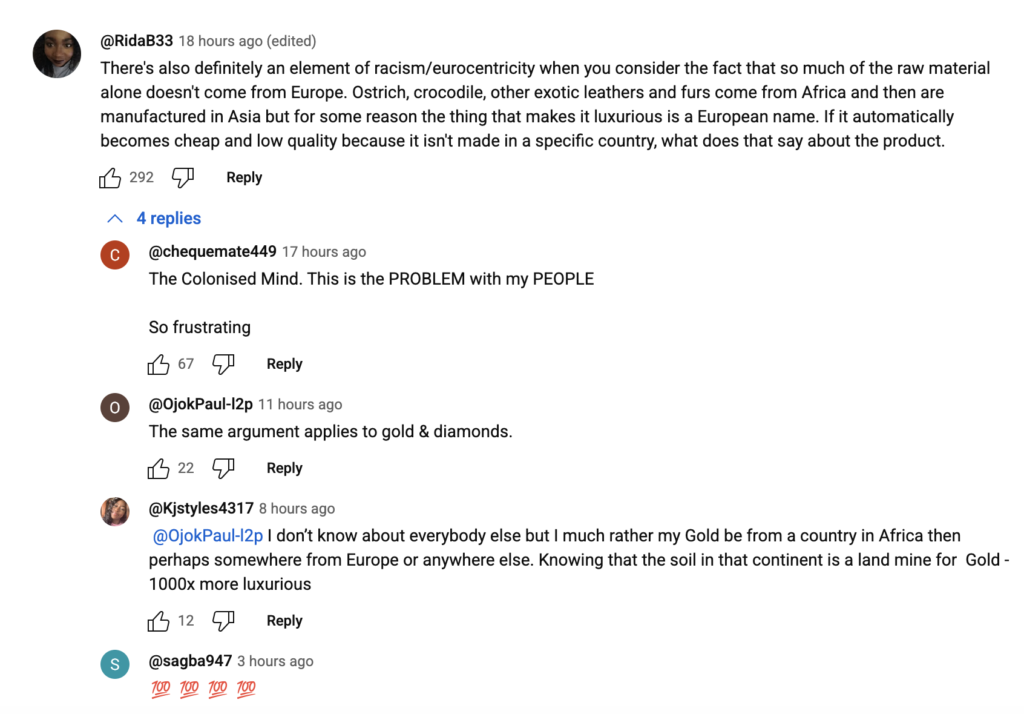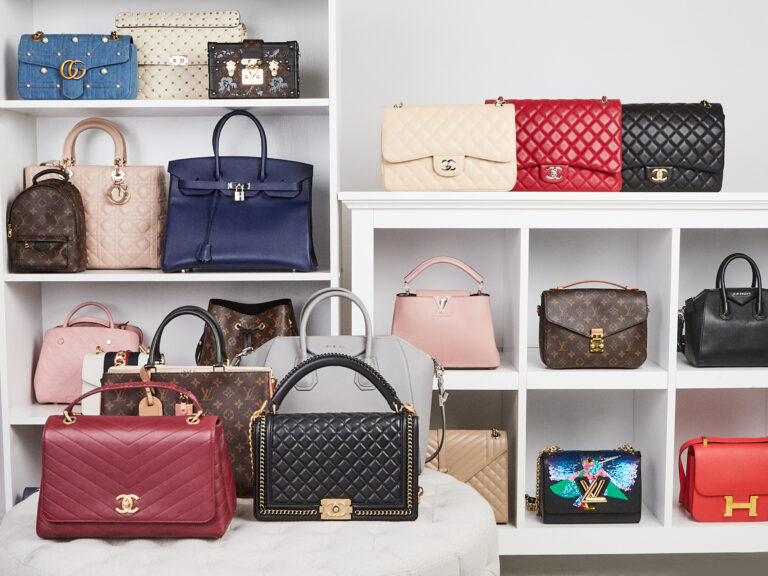The year is 1685, Spain. Your bougie friend invites you over for dinner one day, boasting they’ve got something new and weird to show you. It’s something “exotic” that’ll catch the eye of the aristocrat hotties, they claim. Their brother just brought it back from exploring the New World, a land of people he describes in rather questionable ways.
Nope, it’s not a ship or even fancy new shoes. It’s a pineapple. Yes, pineapples were a status symbol during colonial times — they meant you had the means to set sail to explore other continents since pineapples couldn’t grow in Europe at the time.
Today, luxury labels like Dior, Fendi, Louis Vuitton, and Chanel are status symbols due to their exorbitant prices and their origins in the “sophisticated”, romanticized countries of France and Italy. However, you’ve probably just heard about the Chinese factory workers spreading the word that 80% of their bags are partially manufactured in China, stating that the “Made in [European Country]” labels are only earned because the items’ finishing touches, such as zippers and logos, are indeed assembled in Europe.
The bags are then marked up to over ten times their production cost by retailers to give consumers that astounding price tag.
Some folks on social media are noticing that some luxury lovers are balking at these news: apparently, an item being “Made in China” rather than being “Made in [Fancy European Country]” as previously believed seems to lose part of its psychological value. As someone with a psychology background, I think this behavior unfortunately makes sense: due to persistent negative stereotypes of China manufacturing cheap junk, a “Made in China” label seems to provoke skepticism of an item’s material quality and the ethics behind its production.
View on Threads
Unsurprisingly, LVMH (the company that owns most of these luxury brands) consequently lost a load of its stock value after this discovery got out.
This may not be true for all luxury brands. Some sources claim that some brands, such as Hermés and Prada, do manufacture most or all of their components locally.
Psychologically, it’s well established that the typical intent behind luxury purchases is to infuse the wearer with a sense of visibly prideful “look what I can afford” social prestige. Sometimes, it’s just for a certain aesthetic hard to find elsewhere. But regardless of the buyer’s intent, much of the prestige of luxury brands comes from their reputation for using high-quality materials and craftsmanship in fancy ateliers by master artisans.
View on Threads
The reputation associated with “Made in China” conjures up exactly the opposite imagery. Think traumatic flashbacks of mass-produced, easily accessible dollar store disasters. That “I eat a lot of tacos. What’s your superpower?” T-shirt from Forever 21 that fell apart after a whopping two rounds in the washing machine. And on a deeper and more gruesome level: filthy sweatshops filled with severely underpaid and exploited workers deprived of the dignified employee rights of Western nations.
With that kind of reputation, it’s easy for Americans to forget that half their house—including that fancy air fryer and emotional support water bottle—was also manufactured there. So are several components of their precious Nintendo consoles and Apple Watches.
The balking at the “Made in China” exposé reveals another disturbing layer to the psychological findings above: that much of a brand’s reputation and prestige comes from the knowledge perception that it was made in France or Italy, where most of the brands were founded. Many of these brands do openly promote their European roots through emphasizing their “Made in [Mostly White European Country]” labels, discussing their meticulous manufacturing, choosing designs inspired by local landscapes, hosting fashion shows at historic landmarks like the Trevi Fountain in Italy, and more.
It makes sense why they’d do that. You already know that France and Italy are associated with sophistication, elegance, haute couture, sexy accents, revolutionary history, refinement, romantic languages, baguettes, Mario and Luigi, and exclaiming “Mamma Mia” at the slightest inconvenience. Asian countries aren’t really known for that. On the contrary, you know how widely mocked Chinese accents often are.
Yes, I know China is indeed associated with other horrors such as a repressive government, abysmal human rights (especially for Uyghurs), espionage, firecrackers loud enough to wake the dead, and eating everything that moves.
Unsurprisingly, some folks speculate racism is part of the force behind these brands’ perceived value.

It’s worth noting that several Americans and Asians who have actually visited France and Italy eventually erode some of their idealized views due to repeated negative experiences. The “Paris Syndrome” experienced by some disappointed Japanese tourists is an extreme version of this. Perhaps we should coin a term for the Americans in shock that visiting Japan didn’t amount to stepping into an anime.
Designer labels are also focusing less on brand heritage nowadays and more on the individual vision of creative directors, which may sometimes have absolutely nothing to do with a brand’s country of origin.
Being “Made in China” might not always be horrible
As an American who’s owned a tiny handful of Chanel, Gucci, and Valentino, I don’t think an item being manufactured in China should take away its quality and prestige. Sure, your Gucci wallet might not be as exclusively Italian as you thought it was. But should that matter in 2025 when much of the world’s economy depends on each other in some way? Especially if you got that wallet with the green and red stripes — the colors of the Italian flag. Come on, that thing just screams Italian douchebag.
Let’s be real: it’s not the location, it’s the execution—China can churn out both dollar store disasters and your favorite iPhone. Yes, Chinese manufacturers can make anything from trash bag-quality $6 shirts from Temu to the meticulously sturdy craftsmanship of my inherited $5000+ Chanel bag. Just like with American companies, each factory’s ethics will vary. That’s why some Asian-American fashion designers are actively fighting the “Made in China” stigma by showing proud transparency of their ethical manufacturing practices in China.
Don’t forget that China is the second wealthiest nation in the world, just right after the US and ahead of all of Europe. Yes, it does fall behind most of Europe in GDP per capita and has moderate income inequality, which makes sense that it can have both those aforementioned human rights-fiasco sweatshops and fancy ateliers boasted by those French and Italian brands.
China is far from being a land of peasants, contrary to what JD Vance might assume. Anyone who’s been to a university with plenty of Chinese international students know how outrageously wealthy they are. I’ve been to areas where a strong proportion of the crowd of the local mall’s luxury section seems to be Chinese. China actually was the second-largest market for luxury goods pre-COVID, contributing to a third of global luxury sales.
China does lag behind other Asian countries and much of the West in soft power. However, that seems to be gradually changing due to the popularity of douyin makeup, C-dramas, and the short-lived heartwarming experiences American TikTokers had during their brief exodus to the Chinese app RedNote.
Don’t forget that throughout history, China has been known for producing a lot of things still considered luxurious today: silk robes, porcelain, calligraphy supplies, jade jewelry, and outrageously gorgeous beauty brands unparalleled by those in the US and the Western European countries I’ve visited. Whoops, there goes your bank account.
It looks like China is capable of manufacturing and designing plenty of glamour of their own. No wonder why 85% of luxury consumers in China prefer their own country’s brands.
Should you be concerned about where your luxury bags were manufactured?
Maybe. For some luxury consumers, ethical and sustainable manufacturing is a critical part of the exorbitant price tag. I can understand why learning that part of your bag might have been made in China can provoke skepticism: European countries are known for having better worker rights, fairer pay, and business regulations compared to China. I understand that’s important.
Some buyers have noticed drops in quality after the companies shifted their manufacturing to China:
Some social media users suspect that the widely-circulated luxury exposé may be a covert way to advertise counterfeit goods, assuming that luxury fashion companies are powerful enough to strike back.
However, other individuals point out that ethical and “Made in China” concerns in luxury fashion have been an ongoing issue well before the tariff fiasco of 2025, which means this exposé is just spreading the word. For example, brands such as Dior have been investigated and sued for unethical manufacturing practices with legally unauthorized Chinese migrant labor to technically get that “Made in Italy” label for less. In other words, much of their products were indeed made in Italy — with the same practices that gave “Made in China” such an icky reputation.
So much for fancy ateliers where every surface gleams with artisanal excess, from the velvet pincushions to the antique golden scissors that haven’t cut polyester since the Treaty of Versailles.
It’s true that Italian law does require companies outsourcing production to carry out adequate oversight of their suppliers. But just because something is legally required doesn’t mean a company will abide. Some of you anti-capitalists know that some companies will do anything to increase their profit margins, such as giving employees pizza parties rather than bonuses, buying furniture from sketchy Craigslist sellers, and skirting around local laws.
This sounds like an issue to be taken up with the brand owners or whoever’s in charge of manufacturing conditions. If you’ve got any ideas on how to improve the ethics of luxury manufacturing, drop it in the comments below.
Luxury fashion already isn’t always associated with Europeanness and wealth
Even if that Louis Vuitton bag was 100% made in France, it might not have the rich European vibe you think it does.
Many of us don’t associate luxury fashion with wealth, knowing many of its consumers are actually middle-class rather than wealthy. Only 33% of luxury consumers have a net worth of over $250,000 and only 46% have college degrees. My mom and her brother were definitely not among that when they were buying themselves the Chanel makeup and bags they later passed off to me. “I got that stuff for the looks and quality,” they said.
However, the luxury goods sector experienced strong economic growth between 2019-2023, which means a lot of people either aren’t aware of the above or they just don’t care. Or they’re buying luxury for other reasons than looking like they can sue you anytime, such as aesthetics and quality.
Luxury fashion may be more associated with people of color than European countries, with Black and Hispanic folks making up 49% of its consumers in the US. Internationally, the Asia-Pacific region is actually its largest market.
Why? Psychologists theorize that East Asian cultures may value conspicuous consumption more than other regions due to relatively higher collectivism, which adds more weight on what other folks think of you. The more optics-centered motives behind some of these purchases have been criticized by Asian-American content creators.
There’s obviously nothing wrong with wearing stuff that might be associated with people of color, unless you really don’t like people of color. My point is: these European brands may not be as associated with Europeans or social prestige as much as you think they are.
Should you still wear luxury fashion though?
Yes — if you actually like the item, can’t find a similar product anywhere else, and can accept the possibility your gear might have been the result of an unethical supply chain from Europe and China.
From what I’ve seen, a lot of luxury accessories and shoes flaunt unique aesthetics evoking a distinctive sense of opulence or boldness. Some of them don’t seem to have many affordable alternatives with a similar quality and look. But no need to flesh out $3,000 yet — you can find them secondhand at local consignment shops and online at marketplaces like TheRealReal for a fraction of the price. Or just find designer-inspired bags on Amazon or TJ Maxx.
If you’re going to wear something designer, do it to rock the aesthetic and quality. Don’t do it to feel better or richer than everyone else. Remember, designer labels aren’t a universal sign of affluence, taste, and class. They won’t make you look as fancy as you think it will, unless they actually are predominantly associated with the upper crust in your location. But even then, is it actually worth it to keep up? Just wear it because it makes you look and feel fabulous.
⚠️ A possible blind spot: I’ve never lived anywhere where wearing designer was widely sought after or seen as a sign of class. It’s entirely possible that some of what I’ve said here may not apply to environments where the social norms of luxury fashion differ.
Being healthy might be an even more striking status symbol in 2025. I know that to look fancy in the big California cities where I’ve lived, you’re probably better off carrying around a cup of adaptogenic oat milk coffee or ordering sparkling water at restaurants. Pretend your WeWork desk is your private office or say you “work in finance” if you’re a cashier. For dinner, have a salad named “Kale Me Softly” topped with chakra-aligning activated almonds and a dash of “I found myself in Thailand”.
To look even richer, donate to this website so I can buy some Versace and go to Thailand again. Or just take this poll.



